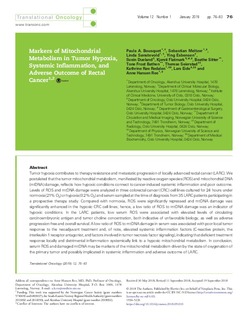| dc.contributor.author | Bousquet, Paula | |
| dc.contributor.author | Meltzer, Sebastian | |
| dc.contributor.author | Sønstevold, Linda | |
| dc.contributor.author | Esbensen, Qin Ying | |
| dc.contributor.author | Dueland, Svein | |
| dc.contributor.author | Flatmark, Kjersti | |
| dc.contributor.author | Sitter, Beathe | |
| dc.contributor.author | Bathen, Tone Frost | |
| dc.contributor.author | Seierstad, Therese | |
| dc.contributor.author | Redalen, Kathrine | |
| dc.contributor.author | Eide, Lars | |
| dc.contributor.author | Ree, Anne Hansen | |
| dc.date.accessioned | 2019-01-03T14:12:46Z | |
| dc.date.available | 2019-01-03T14:12:46Z | |
| dc.date.created | 2019-01-02T12:52:15Z | |
| dc.date.issued | 2019 | |
| dc.identifier.citation | Translational Oncology. 2019, 12 (1), 76-83. | nb_NO |
| dc.identifier.issn | 1936-5233 | |
| dc.identifier.uri | http://hdl.handle.net/11250/2579038 | |
| dc.description.abstract | Tumor hypoxia contributes to therapy resistance and metastatic progression of locally advanced rectal cancer (LARC). We postulated that the tumor mitochondrial metabolism, manifested by reactive oxygen species (ROS) and mitochondrial DNA (mtDNA) damage, reflects how hypoxic conditions connect to cancer-induced systemic inflammation and poor outcome. Levels of ROS and mtDNA damage were analyzed in three colorectal cancer (CRC) cell lines cultured for 24 hours under normoxia (21% O2) or hypoxia (0.2% O2) and serum sampled at the time of diagnosis from 35 LARC patients participating in a prospective therapy study. Compared with normoxia, ROS were significantly repressed and mtDNA damage was significantly enhanced in the hypoxic CRC cell lines; hence, a low ratio of ROS to mtDNA damage was an indicator of hypoxic conditions. In the LARC patients, low serum ROS were associated with elevated levels of circulating carcinoembryonic antigen and tumor choline concentration, both indicative of unfavorable biology, as well as adverse progression-free and overall survival. A low ratio of ROS to mtDNA damage in serum was associated with poor local tumor response to the neoadjuvant treatment and, of note, elevated systemic inflammation factors (C-reactive protein, the interleukin-1 receptor antagonist, and factors involved in tumor necrosis factor signaling), indicating that deficient treatment response locally and detrimental inflammation systemically link to a hypoxic mitochondrial metabolism. In conclusion, serum ROS and damaged mtDNA may be markers of the mitochondrial metabolism driven by the state of oxygenation of the primary tumor and possibly implicated in systemic inflammation and adverse outcome of LARC. | nb_NO |
| dc.language.iso | eng | nb_NO |
| dc.publisher | Elsevier | nb_NO |
| dc.rights | Attribution-NonCommercial-NoDerivatives 4.0 Internasjonal | * |
| dc.rights.uri | http://creativecommons.org/licenses/by-nc-nd/4.0/deed.no | * |
| dc.title | Markers of mitochondrial metabolism in tumor hypoxia, systemic inflammation, and adverse outcome of rectal cancer | nb_NO |
| dc.type | Journal article | nb_NO |
| dc.type | Peer reviewed | nb_NO |
| dc.description.version | publishedVersion | nb_NO |
| dc.source.pagenumber | 76-83 | nb_NO |
| dc.source.volume | 12 | nb_NO |
| dc.source.journal | Translational Oncology | nb_NO |
| dc.source.issue | 1 | nb_NO |
| dc.identifier.doi | 10.1016/j.tranon.2018.09.010 | |
| dc.identifier.cristin | 1648545 | |
| dc.description.localcode | © 2018 The Authors. Published by Elsevier Inc. on behalf of Neoplasia Press, Inc. Thisis an open access article under the CC BY-NC-ND license (http://creativecommons.org/licenses/by-nc-nd/4.0/). | nb_NO |
| cristin.unitcode | 194,65,25,0 | |
| cristin.unitcode | 194,66,20,0 | |
| cristin.unitname | Institutt for sirkulasjon og bildediagnostikk | |
| cristin.unitname | Institutt for fysikk | |
| cristin.ispublished | true | |
| cristin.fulltext | original | |
| cristin.qualitycode | 1 | |

